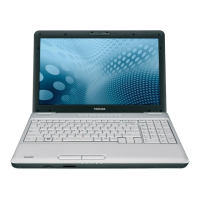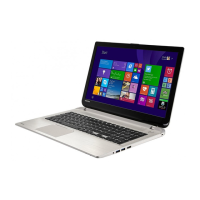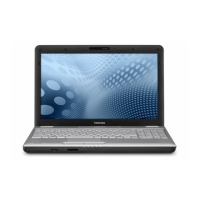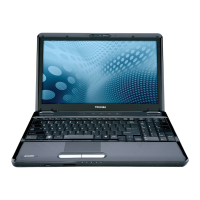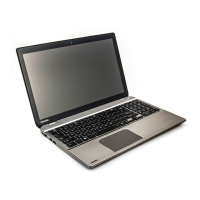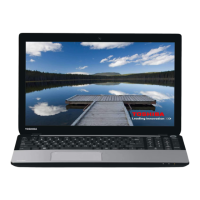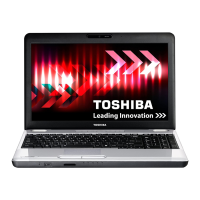
Do you have a question about the Toshiba Satellite L50D-B and is the answer not in the manual?
| Operating System | Windows 8.1 |
|---|---|
| Optical Drive | DVD Super Multi Drive |
| RAM | 4GB DDR3L |
| Storage | 500GB HDD |
| Display | 15.6" HD (1366 x 768) |
| Weight | 2.2 kg |
| Battery | 4-cell Lithium Ion |
| Wireless | 802.11b/g/n |
| Ports | HDMI, RJ-45, Headphone/Microphone combo |
| Dimensions | 380 x 259.9 x 23.5 mm |
Covers copyright, disclaimers, and trademark information.
Details regulatory information, FCC notices, and compliance conditions.
Details CE compliance directives and approved/unapproved working environments.
Information specific to Japan, Canada, and EU states regarding compliance and disposal.
Explains battery disposal and the REACH chemical regulation compliance statement.
Provides disposal info for Turkey/India and a video standard notice.
Details the license terms for the OpenSSL toolkit.
Explains the license terms for the FreeType project.
Details ENERGY STAR compliance and safety for battery disposal and optical drives.
Explains label location and provides general safety precautions for computer use.
Covers proper ventilation, creating a suitable environment, and preventing stress injuries.
Discusses heat injury, proper cleaning, and safe methods for moving the computer.
Covers mobile phone interference, references the safety manual, and explains safety icons.
Lists required hardware and explains manual conventions for clarity.
Guides users through initial setup and usage of the computer.
Provides instructions on how to connect the AC adapter for power and charging.
Details steps for connecting the power cord to the AC adapter and then to the computer.
Explains how to open the computer's display panel safely and correctly.
Guides users on how to turn on the computer's power for the first time.
Covers initial OS setup, getting to know Windows, Start screen, and Charms.
Details Windows features like Charms, Store, and sign-in options.
Explains how to turn off the computer using various modes like Shut Down, Sleep, or Hibernate.
Describes how to shut down, restart, and enter sleep mode for the computer.
Details sleep mode limitations, hibernation, benefits, and execution steps.
Covers benefits, starting, automatic hibernation, and data saving for Hibernation Mode.
Identifies components on the front of the computer with the display closed.
Explains indicators and details ports on the left side of the computer.
Describes LAN, USB ports, optical drive, cooling vents, and right side components.
Provides details on headphone/mic, USB 3.0, USB 2.0/3.0, and HDMI ports.
Covers back panel, underside, RGB port, cooling vents, and security slot.
Details underside cooling vents, battery pack, and the front view with the display open.
Describes the microphone, web camera, and wireless communication antennas.
Details the display screen, speakers, and display hinges.
Covers the power button, indicator, keyboard, and touch pad operations.
Explains the function of the touch pad control buttons for navigation.
Describes the internal battery pack and CPU, including their legal footnotes.
Covers HDD/SSD capacity, Video RAM, and memory modules with legal footnotes.
Explains GPU performance and Intel Display Power Saving Technology.
Details AMD Vari-Bright feature and power condition descriptions for battery status.
Describes the DC IN/Battery and Power indicators and their meanings.
Explains various gestures for interacting with the touch screen.
Details gestures for using the touch pad, including tap and scroll.
Covers keyboard usage, CAPS LOCK, NUM LOCK indicators.
Explains CAPS LOCK, NUM LOCK indicators and the use of function keys.
Covers special Windows keys and generating ASCII characters via codes.
Details supported formats for DVD and Blu-ray drives and how to use them.
Explains how to remove discs and manually eject the tray if needed.
Covers types of writable discs and instructions for writing data.
Provides a disclaimer for writing discs and suggests compatible media manufacturers.
Offers precautions for writing discs and notes on using CyberLink PowerDVD.
Details display/audio settings, starting, operating, and accessing the manual for PowerDVD.
Introduces the TOSHIBA Blu-ray Disc Player software.
Covers display/audio settings, starting, and operating the Blu-ray player.
Explains 3D playback on external devices and important safety information.
Provides further notes on 3D playback, including limitations and content types.
Explains the battery pack as the main power source and the RTC function.
Details proper battery care, charging steps, and approximate charging times.
Provides notices on battery charging and methods to monitor battery capacity.
Offers tips to maximize battery operating time and information on battery exhaustion.
Explains LAN cable types and the process for connecting to a LAN.
Details connecting the LAN cable and introduces memory media slots.
Provides important notes on SD/SDHC/SDXC cards and identifying them by logo.
Covers media formatting, care precautions, and the write-protect feature.
Provides step-by-step instructions for inserting and removing memory media.
Explains how to connect external displays, including the RGB monitor port.
Details connecting external displays via the HDMI out port.
Covers configuring settings for optimal video display on HDMI devices.
Explains wireless display technology and managing display settings.
Details how to connect a security lock and lists optional accessories.
Covers sound system controls and video mode configurations.
Explains volume mixer, microphone level, audio enhancements, and DTS Sound.
Details how to configure video mode settings for optimal display.
Introduces utilities and applications, focusing on TOSHIBA Desktop Assist.
Describes essential utilities like Display, Password, System Settings, and media players.
Covers BIOS setup, eco utility for power saving, and the media player.
Details CyberLink MediaStory, Function Key utility, and Service Station for updates.
Covers PC Health Monitor, media enhancements, and special computer features.
Explains features like automatic power off, sleep/hibernate modes, and battery saving.
Describes Sleep, Hibernation, USB Wakeup functions, and heat dispersal management.
Guides users on setting, deleting, and changing user passwords.
Explains supervisor password setup and how to start the computer with a password.
Covers various system settings like BIOS, Sleep/Charge, Display, Boot, Keyboard, USB, SATA, and LAN.
Explains USB charging capabilities, including Sleep and Charge.
Details Auto Mode, Alternate Mode, and Function under Battery Mode for USB charging.
Explains System ON CDP Charge and usage notes for TOSHIBA Media Player.
Discusses media player features, limitations, and troubleshooting.
Explains the PC Health Monitor application and how to start it.
Provides detailed steps for creating recovery media for system restoration.
Guides on restoring the system from previously created recovery media.
Explains how to restore the system using the recovery partition on the hard disk drive.
Provides instructions on how to order product recovery discs from TOSHIBA.
Outlines a process for solving problems and a preliminary checklist for common issues.
Guides on analyzing problems, focusing on software-related issues and error messages.
Addresses hardware troubleshooting and what to do when programs stop responding.
Covers computer startup problems and a checklist for hardware issues.
Addresses overheating shutdowns, AC power problems, and battery charging issues.
Solves issues related to Real Time Clock, keyboard, and internal display panel.
Troubleshoots HDD boot problems, slow performance, and optical drive access.
Addresses memory card errors and touchpad operational issues.
Solves problems with USB mouse operation and touchpad sensitivity/speed.
Troubleshoots issues where USB devices are not recognized or working correctly.
Addresses problems using the Sleep and Charge function and battery depletion.
Solves problems with sound output and external monitor display.
Provides steps to resolve issues when unable to access the Local Area Network.
Troubleshoots problems with Wireless LAN and Bluetooth device connectivity.
Guides users on how to contact TOSHIBA for technical assistance and support.
Lists physical dimensions and environmental requirements for the computer.
Details power requirements and the pin assignment for the external RGB monitor port.
Covers AC power cord specs and certification agencies for different regions.
Details interoperability standards for Wireless LAN and Bluetooth technologies.
Discusses health considerations for wireless devices and Wireless LAN technology.
Covers RF interference, Bluetooth technology features, and security measures.
Explains radio links and provides European frequency usage restrictions.
Details specific European frequency usage restrictions for Wireless LAN.
Covers Industry Canada (IC) and FCC compliance information for North America.
Provides usage regulations for Taiwan and important notices for Japan.
Explains indications for Wireless LAN and Bluetooth, and information about JEITA.
Lists device authorizations and radio approvals by country/region.
Explains non-applicable icons and legal footnotes on CPU performance.
Covers 64-bit computing, main system memory, and battery life footnotes.
Details HDD capacity, LCD, GPU, Wireless LAN specs, copy protection, and glossary.
Lists and defines common technical abbreviations used in the manual.


